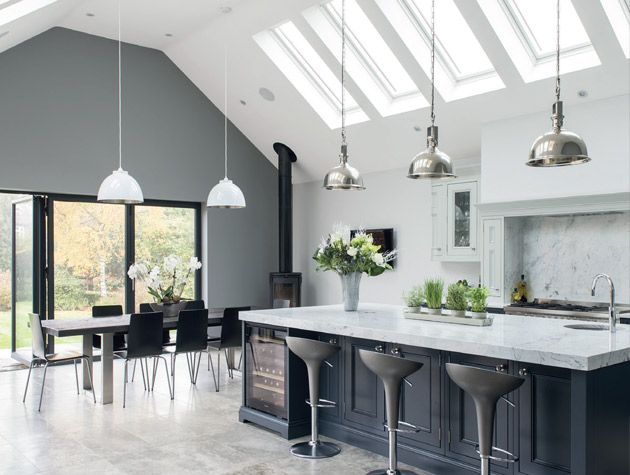How to maximise natural light in your home
Use architectural features and specialised finishes to brighten your space
Natural daylight is intrinsically linked to our mood, boosting the serotonin levels that regulate our emotions, sleep and even memory. That’s why, as we spend an average of 90 per cent of our time indoors, it is important to optimise the levels of light in our homes.
Increased glazing is the principal solution, and with advances in thermal efficiency and intelligent glass products, roof lights, bi-folds and frameless options can all play a part in a considered, well-lit scheme.
While exterior glazing choices have a big impact on how much light enters a house, a successful project should use interior design techniques to help achieve a light-filled space.

Photo: C&C Kitchens
Natural daylight is intrinsically linked to our mood, boosting the serotonin levels that regulate our emotions, sleep and even memory. That’s why, as we spend an average of 90 per cent of our time indoors, it is important to optimise the levels of light in our homes.
Increased glazing is the principal solution, and with advances in thermal efficiency and intelligent glass products, roof lights, bi-folds and frameless options can all play a part in a considered, well-lit scheme.
While exterior glazing choices have a big impact on how much light enters a house, a successful project should use interior design techniques to help achieve a light-filled space.
Let light flow
Choosing glazed elements for walls, doors, ceilings and floors will allow you to achieve continuity of light between rooms. If needed, switchable privacy glass can be used in areas such as en-suites and dressing rooms.
‘Internally, glass is a great way to allow light to continue through a space, and is especially important in narrow buildings, terraced houses, basements and partially underground properties,’ says Rebecca Clayton, marketing manager at IQ Glass. ‘However, you won’t be able to use fully glazed doors if they need to be fire rated.’
The orientation of a building will also affect the amount of light it receives, so when planning a new build or extension, design the glazing with this in mind. The height of neighbouring buildings and trees can cause shading, but this can be resolved by keeping surrounding planting at a low level, and opting for pale exterior surfaces to give the illusion of brightness.

Photo: IQ Glass
Use clever finishes
Just as paler hues will make a room feel brighter, reflective surfaces can also help to increase how light a space seems. Gloss cabinetry and pale, polished worktops are good choices for kitchens, as well as materials such as stainless steel, aluminium and copper; but take care with overly shiny or bright surfaces as they can cause glare.
‘Large, reflective glass splashbacks can bounce too much light back into a space,’ says Daniele Brutto, co-founder of Hub Kitchens. ‘Use a satin glass finish for a more subtle effect.’
Large-format tiles, neutral flooring and mirrored walls are other methods used by architects and designers to increase the feeling of light, and now paint manufacturers are getting on board with research into lustrous paint technology. Dulux has launched a Light & Space paint range, which uses light-reflective particles to cast up to twice as much light back into a room.
‘Interior designers are now using high gloss and lacquered paint finishes, previously reserved for woodwork, on walls and even ceilings,’ says Martin Holland, interior designer at Martin Mark Design.

Photo: Juliet Murphy
Open up spaces
Staircases and hallways are often dominated by solid walls on either side, and are notoriously enclosed and gloomy. They can be transformed into a bright and spacious-looking design feature with glass balustrades, open treads and integrated lighting.
‘LEDs can be fitted underneath engineered treads or along the wall string to create a range of effects and give the illusion of space in a confined area,’ says Scott Storey, managing director at James Grace Staircases.
‘When dealing with a dark entrance hall that suffers from a lack of light, think about the adjacent rooms and what they can offer to make the space feel more open,’ adds Holland. ‘By replacing all or part of a dividing wall with a run of shelving that’s open on both sides, the previously darker space can borrow light from the adjoining room. This simple solution also reduces the disconnection normally felt between the hallway and the rest of the house.’
As well as these more drastic changes, there are plenty of small steps you can take to boost the light levels in your home. Remove heavy window treatments and replace them with sheer fabrics that allow light to filter through but still offer privacy.
Replace bulky, dark furniture with glass or acrylic styles that won’t dominate the room and absorb light. Finally, consider your lighting options.
Supplement ambient lighting with task options in frequently used areas, and accent fittings to illuminate special features or dark corners.









